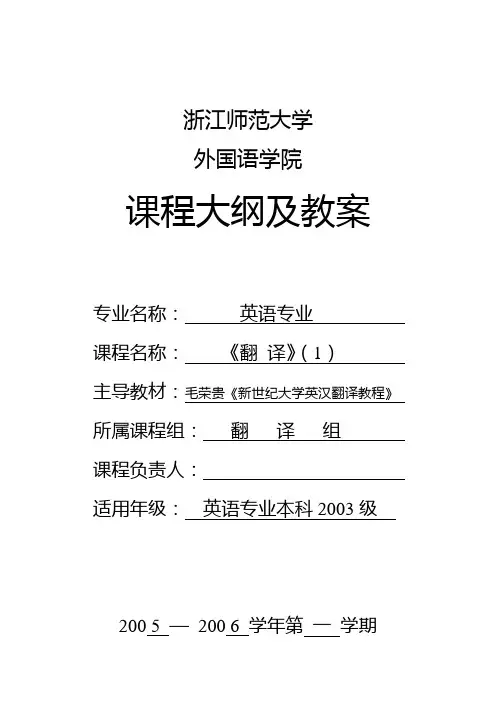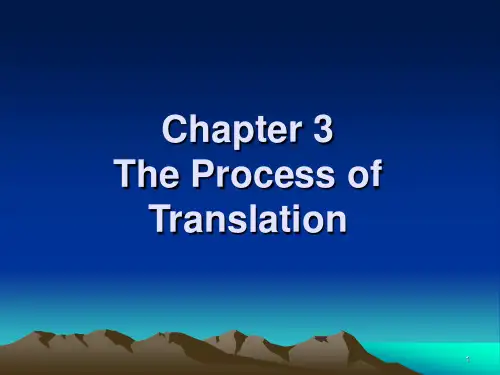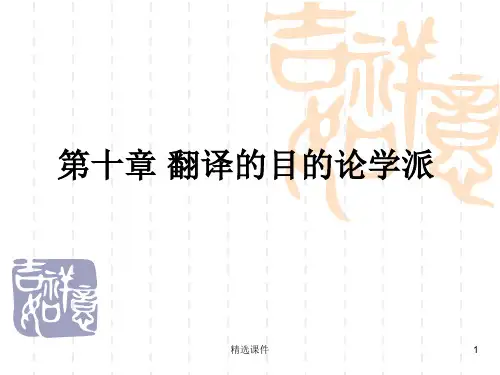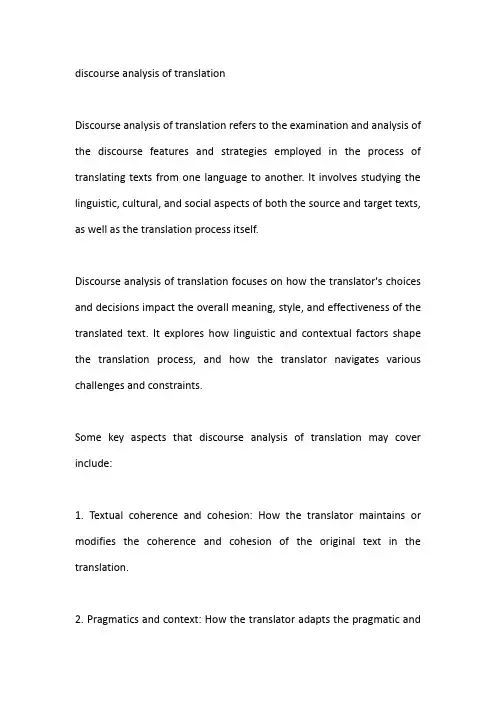1-01-Translation Analysis
专业英语翻译教案

浙江师范大学外国语学院课程大纲及教案专业名称:英语专业课程名称:《翻译》(1)主导教材:毛荣贵《新世纪大学英汉翻译教程》所属课程组:翻译组课程负责人:适用年级:英语专业本科2003级200 5 —200 6 学年第一学期翻译(1)(2)课程大纲一、课程概况课程名称:翻译课程类别:专业基础课课程编号:030903081,030903082学分:4 学时:68 开课学期:五、六二、课程教学目标和要求1、[教学目标]通过本课程的教学,帮助学生有效提高翻译实践能力和理论认识,达到高等学校英语专业英语教学大纲对其翻译能力的基本要求,即:能运用翻译理论与技巧,将英美报刊上的文章以及文学原著译成汉语,或将我国报刊、杂志上的文章和一般文学作品译成英语,译文忠实、流畅,译速每小时250-300个英文单词汉字,使之可以胜任未来的中学英语教学以及其他涉及翻译能力的工作。
2、[课程要求]本课程为系列专业基础课,由英译汉和汉译英组成,要求学生按顺序修读。
为达到课程教学的目的,采用讲练结合的方式,布置相当数量的课后作业要求学生按时按量完成,并积极参与课堂讨论。
三、教学内容与教学安排1、[教学内容要点]本课程教学以实践为主,理论为辅,重点是翻译技巧的介绍与练笔,翻译内容涉及各类文体、各个领域。
课程安排按照讲练结合的原则展开,帮助学生有步骤有针对性地训练翻译的基本技能。
通过大量的练习和讲评,强化学生对不同文本语体特点和翻译原则的认识,为其将来从事翻译工作或运用英语作为工作语言打下坚实的双语转换实践基础。
2、[教学安排]本课程教学依据教学大纲,安排在本科三年级上、下两学期进行,共计68学时,其中36学时为英译汉,32学时为汉译英,每周2学时。
教学计划允许授课教师在具体操作中有一定的灵活度,但至少应包含以下3部分的主题内容:1)翻译概述(含翻译的标准、原则、过程、中外翻译简史及翻译名家的主要观点等);2)翻译技巧讲练(介绍主要的英汉互译技巧,结合学生的练笔进行讲评);3)多视角的翻译实践与研究(不同领域的翻译实践及其操作原则与技巧,如外来词翻译、报刊标题及新闻翻译、旅游翻译、科技翻译、广告翻译、文化与翻译等;在实践的基础上开始涉猎翻译的前沿理论,提高学生对翻译的理性认识,目的在于训练其解决问题的探索能力,为其将来从事翻译实践或理论研究开辟一个窗口)。
翻译研究笔记 重要

Chapter 1:Main issues of translation studies:1. Jacobson’s categories of translation:a. Intralingual;b. Interlingual;c. Intersemiotic (verbal- non-verbal).2.History of the discipline:a. From the late 18th to the 1960s – grammar-translation method (replaced by communicative approach in the 1960s and 1970s);b.The USA 1960s –translation workshop concept based on Richards’reading workshops and practical criticism approach that began in 1920s; running parallel to this approach was that of comparative literature;c.The USA 1930s-1960s/70s – contrastive analysis;d.More systematic, and mostly linguistic-oriented, approach 1950s-1960s:i.J.-P. Vinay and J. Darbelnet (French/English);ii. A. Malblanc (French/German);iii.G. Mounin (linguistic issues of translation);iv. E. Nida (based on Chomsky generative grammar).v.James S. Holmes’“The name and nature of translation studies”is considered to be the founding statement of a new discipline.vi.Hermans Manipulation Schoolvii.Vieira Brazilian cannibalist school Postcolonial theoryviii.Venuti cultural-studies-oriented analysisThe Holmes/Toury map of translation studies1:Chapter 2: Translation theory before the 20th century:Traduttore, traditore = the translator is a traitorChapter 3: Equivalence and equivalent effect:In the 1950s and 1960s the place of circular debates around literal and free translation took the new debate revolved around certain key linguistic issues, among them those of meaning and equivalence, discussed by R. Jakobson in 1959. Over the following 20 years many further attempts were made to define the nature of equivalence.Jakobson:1.Meaning: the signifier=the signal of the signified (the concept).2.There is no full equivalence between code-units of different languages.3.So, we should substitute not words, but messages.4.Only p oetry is considered ‘untranslatable’ and requires ‘creative transposition’.Nida’s ‘science of translating (subjective):1.Meaning:a.Linguistic;b.Referential (dictionary meaning);c.Emotive (connotative).2.Ways of determining meaning:a.Hierarchical structuring (animal dog, cow etc);ponential analysis (grandmother, mother, cousin etc);c.Semantic structure analysis (spirit can mean demon, angel, god, ghost, ethos, alcohol etc)meaning depending on context.3.3-stage system of translation (Chom sky’s influence: deep/surface structure of a language):SL1 (analysis) X (transfer) Y (restructuring) TL24.Equivalence:a.Formal (form and content);b.Dynamic (equivalent response of: t2 reader on t2 as t1 reader on t1) (closest naturalequivalent).5.Correspondence in meaning must have priority over correspondence in style.6.Reader-based orientation.主要理论1:对等和等效(1950s-1960s)1.代表人物(1)罗曼雅各布逊A.描写了翻译的三类型:语内翻译,语际翻译和符际翻译B.提出语际翻译指用一种语言替换另一种语言种的整个信息C.强调对等的差异性(2)尤金奈达A. 提出形式对等和动态对等B. 提出著名的读者反应理论C. 他的理论以乔姆斯基的转换生成语法为基础(3)皮特纽马克A.提出语义对等和交际对等(4)韦内科勒A.区分了对应和对等B.描写了五种对等:外延意义,隐含意义,文本规则,语用及形式对等Newmark’s semantic and communicative translation:1.Replaces Nida’s division with semantic (resembles formal equivalence) and communicative(resembles dynamic equivalence) translation.2.Nida’s division inoperant if the text is out of TL space and time.3.Dynamic equivalence: are readers ‘to be handed everything on a plate’?4.Semantic translation differs from literal in that it ‘respects context’, interp rets and explains(metaphors). Literal translation is to be the best approach in both semantic and communicative translation. If semantic translation would result in an ‘abnormal’ TT or would not secure equivalent effect in the TL, then communicative translation should win out.Tertium comparationis, an invariant against which 2 text segments can be measured to determine variation.Chapter 4: The translation shift approach:1.Vinay and Darbelnet’s taxonomy:a)Direct (=literal) translation:(1).Borrowing(2).Calque(3).literal translation (word-for-word)b).Oblique translation:(4).Transposition(5).modulation6(6)..equivalence(7).adaptationc)The 7 categories operate on 3 levels:1.the lexicon2. 2.syntactic structures3. 3.the message 9context)4. 4.word order and thematic structure5. 5.connectors [cohesive links, discourse markers, deixis (pronouns anddemonstrative pronouns) and punctuation]d)2 possibilities:1.servitude (obligatory 4 and 5)2. 2.option (non-obligatory)2.Catford’s linguis tic approach (shifts)a.Distinction between: formal correspondence (a particular ST-TT pair) and textualequivalence (a pair of lgs).b.When the 2 concepts diverge, a translation shift occurs –a departure from formalcorrespondence in the process of going from the SL to the TL. There are 2 kinds of shift:1. A level shift (sth is expressed by grammar in one lg and by lexis in another)2. A category shift:i.Structural shifts; ii.Class shifts (word category); iii.Unit/rank shifts (sentence, clause,group, word, morpheme);iv.Intra-system shifts (systems are similar, but not always corresponding).3. van Leuven-Zwart’s microlevel/macrolever translation shifts:a.The comparative model (a detailed comparison of ST and TT and classification of allthe microstructural shifts within sentences, clauses and phrases);b.The descriptive model (a macrostructural model, designed for the analysis oftranslated literature)Chapter 5: Functional theories of translation:K. Reiss’s text typesNord adds to 3 types of language function a fourth ‘phatic’ function, covering lg that establishes or maintains contact between parties involved in the communication (e.g. greetings).Holz-Manttari’s translational action model for non-literary translations with1.its roles and players:a The initiator;b b.The commissioner (contacts the translator);c.The ST producer;d.The TTproducer;e.The TT user;f.The TT receiver.2.Content:a Factual information; b.Overall communicative strategy.3.Form: a.Terminology; b.Cohesive elements.J. Vermeer’s skopos theory: knowing the purpose and the function of translation is crucial (adequacy over equivalence).Ch. Nord’s translation-oriented text analysis:1.2 kinds of translation: a.Documentary translation(a)reader knows that he’s reading a translation;(b)Instrumental translation (a reader doesn’t know that).2.3 aspects of functionalist approaches particularly useful in translator training:a)The importance of the translation commission;b)The role of ST analysis;c)The functional hierarchy of translation problemsChapter 6: Discourse and register approaches:Halliday’s model of language and discourse b ased on systemic functional grammar (lg=communication):Influence:House’s model of translation qu ality assessment:1.Scheme for analyzing and comparing original and translation texts:Translation: a.Overt;b.Covert.Baker’s text and pragmatic level analysis:1.Textual function2.Cohesion3.Pragmatics:a.Coherence (depends on receiver’s expectations and experience of theworld);b.Presupposition (what the speaker supposes a listener shouldknow);c.Implicature (what the speaker implies).Hatim and Mason’s semiotic level of context and discourse:Text elements:1.Stable (translated fairly literally);2.Dynamic (not).Chapter 7: Systems theories:脚注:1.What is being written about.2.Who is communicating and to whom.3.The form of communication e.g. writtenEven-Zohar’s polysystem theory: a literary work as apart of a literary system in the social, cultural, literary and historical framework. It’s important [for choosing the translation strategy] if translated literature has a primary or secondary position in given literature.Toury and descriptive translation studies (DTS):1.Situate the text within the target culture system, looking at its significance oracceptability;2. pare the ST and the TT for shifts, identifying relationships between ‘coupled pairs’of ST and TT segments, and attempting generalizations about the underlying concept of translation;3. 3.Draw implications for decision-making in future translating.Norms of translation behaviour can be reconstructed from:1.The examinations of texts;2. 2.The explicit statement made about norms by translators, publishers, reviewers and otherparticipants in the translation actNorms:1.Initial norm (general translator’s choice):a.Subjection to source culture norms adequate translation;b.Subjection to target culture norms acceptable translation.2.Preliminary norms:a.Translation policy (text selection);b.Directness of translation (ST TT; ST t2 TT).3.Operational norms (the presentation and linguistic matters of the TT):a.Matricial norms (completeness of TT);b.Textual-linguistic norms (TT linguistic material).‘Laws’ of translation:1.Of growing standardization (tending to TT common options);2.Of interference (ST options transferred to TT, negatively or positively).Chesterman’s translation norms:1.Product or expectancy norms;2. 2.Process or professional norms:a.The accountability norm (an ethical norm);b.The communication norm (a social norm);c.The‘relation’ norm (a linguistic norm).Other DTS models:1.Manipulation School (‘a continual interplay between theoretical models and practical casestudies’);mbert and van Gorp – the scheme for the comparison of the ST and TT literary systems andfor the description of relations within them:a.Preliminary data;b.Macro-level;c.Micro-level;d.Systemic context (data compared andnorms identified)Chapter 8 "Varieties of cultural studies" examines Lefevere (1992), who treats translation as "rewriting" and identifies ideological pressures on translated texts. This chapter also looks at the writing of Simon (1996) on gender in translation, and at postcolonial translation theories which stress the part that translation has played in the colonization process and the image of the colonized (cf. Bassnett and Trivedi 1999).Lefevere (1992) treats translation as "rewriting" and identifies ideological and poetological pressures on translated texts. Translation functions are controlled by the following factors:1.Professionals within the literary system;2.Patronage outside the literary system:a.The ideological component;b.The economic component;c.The status component.d.If a-c come from the same source – patronage is undifferentiated; if not – differentiated.3.The dominant poetics:a.Literary devices;b.The concept of the role of literature.Simon compares the status of translation throughout the centuries to that of women’s and presents pro-feminist methods in translation.Postcolonial translation theories:1.Spivak: ‘translationese’ eliminates the identity of politically less powerful individuals andcultures.2. 2.Spivak: compares the status of translation throughout the centuries to that of colonies.3.Power relations : trans lation as the colonizer’s device used against the colonized.4.S. Bassnett and H. Trivedi’s translational linked to transnatio nal (translation=battleground).Brazilian cannibalism: the colonizers and their lg are devoured, their life force invigorating the devourers, who transform it according to their needs.The Irish context: postcolonialism in Europe.Chapter 9: Translating the foreign:the (in)visibility of translation: A. Berman’s ‘negative analytic’ of translation that prevents the foreign coming thr ough. ‘Deforming tendencies’:1.Rationalization;2.Clarification;3.Expansion;4.Ennoblement;5.Qualitative impoverishment;6.Quantitative impoverishment;7.The destruction of rhythms;8.The destruction of underlying networks of signification;9.The destruction of linguistic patternings;10.The destruction of vernacular1 networks or their exoticization;11.The destruction of expressions and idioms;12.The effacement of the superimposition of languages.‘Positive analytic’ = literal translation.Venuti:1.The invisibility of the translator in contemporary Anglo-American culture.2. 2.Domestication (dominant in connection with the translator’s invisibility) –‘the authortowards the reader’.3. 3.Foreignization –‘the reader towards the writer’ – resistancy – minoritizing (desirable).4. 4.‘Call for action’ –‘visibility’ + ‘foreignization’.Chapter 10: Philosophical theories of translation:Steiner’s hermeneutic1 approach to translation as ‘the act of elicitation and appropriate transfer of meaning’. The parts of the hermeneutic moti on:1.Initiative trust;2. 2.Aggression (penetration);3. 3.Incorporation (embodiment);4. pensation (restitution)Ezra Pound’s energy of language: translation as a tool in the cultural struggle, and the revitalization of the past.W. Benjamin’s task of the translator: translation gives the original ‘continued life’; pure language = coexistence of SL and TL; literal rendering of the syntax.J. Derrida’s deconstruction: capturing the meaning? No stability in the signified-signifier (meaning-sign) relationship; the opposition between SL and TL.1.Letter=Judaism=justice;2.Spirit=Christianity=mercy.Chapter 11: Translation studies as an interdiscipline:M. Snell-Hornby’s integrated approach.Harvey’s combination of linguistic analysis and critical theory.。
英汉翻译 process of translation

17
• 王小玉便启朱唇、发晧齿,唱了几句书 儿。 • 译文1:Now open her rosy lip and her ivory white teeth shine, her song begins! • 译文2:Little Jade Wang then opened her vermilion lips, displaying her sparking white teeth, and sang several phrases. • 译文3:Little Jade then parted her lips and sang a few lines.
8
译1: 一月三十一日,史迪威抵达德里。尽 管他对这个会议的态度十分消极,但最少 在二十九天来,他第一次有了个洗澡的机 会。
译2::一月三十一日,史迪威公开露面, 去德里参加会议。这次会议在他看看来不 管有多么消极,至少为他提供了一个二十 九天以来第一次洗澡的机会。
9
(3) Clare stood still, and inclined his face towards hers. “Oh, Tessy!” he exclaimed. The girl’s cheeks burned to the breeze, and she could not look into his eyes for the emotion. (Hardy: Tess ,Ch. 23)
accurate comprehension
smooth expression
Careful proof reading
the prerequisite of translation
a key factor
correcting & improving
翻译的目的论学派

精选课件
5
▪ 信息功能文本(informative)——译文应 该充分传达原文的指涉功能,信息翻译应该 直白易懂。
▪ E.g.: These statement are worth taking with a basketful of salt.
▪
这些话的可信度应大打折扣。
精选课件
6
▪ 表情功能文本(expressive)——译文应 传达原文的审美以及艺术形式,使用“认 同法” (identifying method),即译者应 采用原作者的视角。
▪ And the “boudoir romance”… Still worse is the “erotic novel”…(David Hawkers译)
精选课件
18
▪ 目的论将翻译研究的视线从原语转移到 译入语,对突破对等思想的禁锢有重要意 义。但是将“目的”作为翻译行为的首要 准则,指导翻译策略。在本质上还是规定 性的,很难避免应用理论的通病。目的论 虽然声称是一种普遍的翻译理论,但事实 上主要用于商业文本,其对文学翻译研究 的可行性一直受到质疑。
精选课件
4
▪ 早期理论:主要围绕对等概念展开,认为 翻译追求的对等应该是语篇层面的对等, 而不是词、句的对等,所以主张把翻译策 略和语言功能、文本类型以及文章体裁结 合起来考察。
▪ 后期理论:她认识到在翻译实际中不可能 实现真正的对等,于是她逐渐将研究的目 光转向翻译的目的,成为翻译研究目的论 的开创者。
精选课件
21
▪ 她把翻译看作包括文本、图片、声音、肢 体、语言等复合信息传递物(messagetransmitter compounds)在不同文化间的 迁移,用“翻译行为”(translational action)来代替翻译(translation),以表 示各种各样的跨文化交际行为。
discourse analysis of translation

discourse analysis of translationDiscourse analysis of translation refers to the examination and analysis of the discourse features and strategies employed in the process of translating texts from one language to another. It involves studying the linguistic, cultural, and social aspects of both the source and target texts, as well as the translation process itself.Discourse analysis of translation focuses on how the translator's choices and decisions impact the overall meaning, style, and effectiveness of the translated text. It explores how linguistic and contextual factors shape the translation process, and how the translator navigates various challenges and constraints.Some key aspects that discourse analysis of translation may cover include:1. Textual coherence and cohesion: How the translator maintains or modifies the coherence and cohesion of the original text in the translation.2. Pragmatics and context: How the translator adapts the pragmatic andcontextual elements of the source text to the target language and culture.3. Register and style: How the translator deals with differences in register, style, and tone between the source and target texts.4. Ideology and power relations: How the translator negotiates ideological and power dynamics present in the source text and target culture.5. Intertextuality: How the translator handles intertextual references and cultural references in the translation.6. Translation strategies: How the translator employs various translation strategies, such as literal translation, adaptation, compensation, paraphrasing, or cultural substitution.By analyzing these aspects, discourse analysis of translation aims to shed light on the complex nature of translation as a communicative and cultural practice, and to understand the impact of translation choices on the target text and its reception.。
MTI书单

1.笔译何刚强.《笔译理论与技巧》北京:外语教学与研究出版社,2009.孙致礼, 周晔.《高级英汉翻译》北京:外语教学与研究出版社,2009.陈宏薇.《高级汉英翻译》北京:外语教学与研究出版社,2009.李长栓.《非文学翻译》.外语教育与研究出版社.2009姜秋霞,外事笔译[M].北京:外语教学与研究出版社, 2009.何其莘,仲伟合,许钧,《高级文学翻译》外语教育与研究出版社.2009王宏印,《中国文化典籍英译》外语教育与研究出版社.2009王维东,《翻译批评与赏析》外语教育与研究出版社.2009钱多秀等,《计算机辅助翻译》外语教学与研究出版社; 2011.穆雷,《翻译研究方法概论》外语教育与研究出版社.20092.口译柴明颎,《专题口译》,外语与教学研究出版社,2009.7何群,李春怡编著,《外交口译》,外语教学与研究出版社,2011.3梅德明,《高级口译教程》,上海外语教育出版社,2006.赵军峰,《商务英语口译(第二版)》,高等教育出版社,2009.仲伟合,《英语同声传译教程》,高等教育出版社,2008年。
吴冰,《现代汉译英口译教程》,外语教学与研究出版社,2010年。
严诚忠,戚元方编著,《高级口译教程》上海外语教育出版社,2001,3徐亚男,李建英主编,《外事翻译:口译及笔译技巧》世界知识出版社,2003,3秦亚青,《英汉视译》,外语教学与研究出版社,2009仲伟合,《英语口译教程》,高等教育出版社,2007姜秋霞,《实用外事英语翻译》,商务印书馆,2011陶友兰、鲍晓英,《高级英语口译:理论技巧与实践》,上海译文出版社,2008《口译研究方法论》,仲伟合等著,外研社,2012《口译研究的路线图——《口译研究概论的》导读》,仲伟合,王斌华,上外社,2009《口译理论概述》,鲍刚,旅游教育出版社,1998《口译技巧》,刘和平,中国对外翻译出版公司,2001《口译理论与教学》,刘和平,中国对外翻译出版公司,2005冯建中:《实用英语口译教程》,南京:译林出版社,2002年--《口译实例与技巧》,太原:书海出版社,2007林超伦:《实战口译》,北京:外语教学与研究出版社,2004年仲伟合:《英语口译教程》北京:高等教育出版社2006年《英语备考词汇全攻略》(2级,3级),周国强,郭鸿杰,外文出版社《英语口译实务》,梅德明,外文出版社《英语口译全真模拟试题及解析》,卢敏,外文出版社《实用汉字速记》,史江等,成都:四川大学出版社,2000《英语口译笔记法实战指南》,吴钟明,武汉大学出版社,20053.理论许钧,《翻译概论》,译林出版社, 2009.3[英]杰里米•芒迪译者:李德凤等,《翻译学导论——理论与实践》商务印书馆。
零翻译类型研究_李家春
零翻译类型研究*李家春(黑龙江大学,哈尔滨150080;上海外国语大学,上海200083)提要:零翻译作为翻译方法之一,其内涵和外延仍不够清晰。
我们在系统调查零翻译使用现状的基础上,重新界定零翻译,并从多角度对零翻译进行分类。
我们认为,不能忽视零翻译存在的客观性、广泛性和多样性,不应一刀切地赞成或反对零翻译,应该从语篇类型、产生媒介、呈现方式等多个层面进行理性分析。
关键词:零翻译;语言政策;语篇类型;语域中图分类号:H059文献标识码:A文章编号:1000-0100(2013)03-0095-5On the Types of Zero TranslationLi Jia-chun(Heilongjiang University,Harbin150080,China;Shanghai International Studies University,Shanghai200433,China)Zero translation,as one of the translation methods,should have clear connotation and denotation.On the basis of the sys-tematic investigation of the use of zero translation,we try to redefine the concept of zero translation and make a clearer classifica-tion.We can not ignore its objectivity and diversity,and we should not be absolutely in favor of or against the zero translation.We should judge from the genre of discourse,media,ways of presentation and other perspectives.Key words:zero translation;language policy;genre;register1零翻译界定目前,零翻译的外延并不明确。
翻译的过程
?
?1. 语义分析
? 语义分析(Semantic Analysis)是语言 分析的一个分支,说明处在一定语境中, 按照一定次序排列的词项之间的语义关系, 探索词项的意义。把握好原语的全部意义, 是翻译成效的关键。
? 1)首先,必须注意词的概念意义(Conceptual Meaning) 和关联意义(Associative Meaning)。
翻译的过程
一般认为,翻译过程包括两个阶段:正确理解 (Accurate Comprehension )和充分表达( Adequate Representation )。前者是后者的前提,后者是前者 的结果,两者是有机的统一,是使译文符合“忠实、 通顺”的翻译标准的必备条件。
一、理解阶段
? 理解(comprehension)可分为广义理解和狭义理解。广义 理解指对原文作者的个人、原文产生的时代背景、作品的内容 以及原文读者对该作品的反映。狭义的理解仅指对原作文本的 理解。这中理解主要包括语法分析、语义分析、语体分析和语 篇分析(grammatical analysis, semantic analysis, stylistic analysis and text analysis)。理解是翻译成功与否的先决条件 和重要步骤,务必正确可靠,杜绝谬误。
1. Diligence is the mother of good luck.勤勉是幸运之源。 2. No news is good news. 没消息就是好消息。 3. A stitch in time saves nine. 小洞不补大洞吃苦/一针不缝九针难补,及时处理事半 功倍。
汉英对比翻译
翻译方法:直译(literal translation)和意译(free translation)
直译:既保持原文内容,又保持原文形式的翻译方法或翻译文字。 意译:只保持原文内容、不保持原文形式的翻译方法。 1. 词语中的直译与意译 (1)the moon 直译:月亮 意译:玉兔(~东升);金兔;白兔;蟾宫(~蟾宫折桂); 月桂(一轮~);婵娟(但愿人长久,千里共~<宋· 苏轼词>);水 镜;阴宗 (2) 月亮 直译:the moon 意译:celestial body, heavenly body, planet, secondary planet, planetoid, orb of night, moon goddess, green cheese, Diana, Luna, Cynthia, queen of night(Shakespeare), chaste and fair (B.Johnson)
• • • • • • • • • • •
satellite city; fiscal income; to lay off somebody/laid-off workers; banquet hall; Rare animal; laptop/notebook computer; enrollment; garment company; ticket income; dairy foods/products; to take Chinese medicine/herbal medicine; in-bound visitors/tourists; client; 25th wedding anniversary; economic crisis; circulation; adult education; World Economic Forum
Introduction to translation studies
Definitions of translation
The target language should be easy and smooth for people to read. Communicate with people speaking different languages, eg. exchange ideas or culture.
Characteristics of translation
Translate what is written or what is spoken. No right to change and correct the source language. To understand the source text and to express in the target text . Should not stick to the original meaning in translate and make your translation meet the customary expressions in the target language.
Translation Studies (Translatology)
Translatology is a general term of translation studies Translation Studies is the top level of translation Elements of social science and the humanities Dealing with the systematic study of the theory The Description and the application of translation, interpreting Translation can be Normative and Descriptive
- 1、下载文档前请自行甄别文档内容的完整性,平台不提供额外的编辑、内容补充、找答案等附加服务。
- 2、"仅部分预览"的文档,不可在线预览部分如存在完整性等问题,可反馈申请退款(可完整预览的文档不适用该条件!)。
- 3、如文档侵犯您的权益,请联系客服反馈,我们会尽快为您处理(人工客服工作时间:9:00-18:30)。
Translation1. Mr. Manager, may I take a day off tomorrow? My mother is coming to see me.表示将来的will, be going to 与现在进行时三者用法的异同1.说话时临时起意或表示“愿意,决心要”的将来行动→willA: This is so heavy a box. B: I will help you to carry it.2.在此之前主语单方面的决定或计划(并非临时起意)→be going toA: why did you buy this paint? B: I’m going to paint my bedroom tomorrow.注:come, go, arrive, leave, fly, start, travel, drive等表示从甲地到乙地的行动的动词,stay, remain等表示位置的动词,do以及表示吃喝的have(后接食物或饮料)可以(并非必须)用现在进行时代替be going to 表示主语单方面的决定的将来行动。
3.说话时,主语已和他人约定的将来行动→现在进行时My wife has an appointment with a doctor. She is seeing Dr. Wang next Monday.4.非既定计划,预测将来的行动或可能发生的事;或不明确是否预先计划→ will/ be going toI will/am going to climb that mountain one day.5.根据某种征兆预测“最近”会如何→be going to; 根据个人看法预测“迟早”会如何→ willListen, there is a strange sound. The lift is going to be break down; we had better get out on the next floor.The lift will break down since it is often overloaded.c.f. My mother will come to see me. (be doing更好: the present continuous tense indicating a scheduled action in the near future. p.3I’m flying back to America tomorrow.)Exercise:A: Where’s your car?B: It is in the garage for repair.A: How are you going to get to work?B: I am going to take the bus. (送车去修时已决定坐公交,既定决定,不可用will;单方决定并非约定,不可用I’m taking)A: You needn’t take the bus. I will drive you. (A临时决定载B,并非预定计划或约定)LaterC: How are you going to get to work, Mr. B?B: Mr. A is driving me. (A和B已经约定)2. The police offered a reward for clues about the bank robbers.sin / crime (Every crime is normally a sin, but not every sin is necessarily a crime. )sin: an action, thought or way of behaving that is wrong according to religious laws. // an action or way of behaving that you think is morally wrong →sinner: someone who does sth morally wrong or does not obey religious laws.Greed and lying are sins. // it is a sin to waste food when so many people are starving.crime: an illegal activity or action. → criminal: one who has committed a crime.A convicted criminal: one who has been judged guilty in a court of law. 已决犯,既决犯A hardened criminal: one who has committed many crimes. = A habitual criminalA wanted criminal: 通缉犯Generic words vs. specific words:murder: the crime of killing someone deliberately→ murderer: someone who commits murderrobber: someone takes money or property illeglly, often by using threats and violence.reward / awardreward: 1)sth. good that happens or that you receive because of something you have done. 因做某事给予的报酬a reward for doing sth. / give sb. a reward for sth. (for =because of) = reward sb. for sth因某事奖赏~+for You deserve a day off as a reward for working so hard.(c.f. reward sb. with sth: they rewarded the winner with flowers.以某物奖赏)2) money that someone receives for finding and returning sth. or for helping the police悬赏:post a reward / offer a rewardaward: 1)a prize or other reward that is given to someone who has achieved something. 奖品,奖状→ money granted to a student at a university 奖学金win/receive an award // give/ grant present an award2) an amount of money or judgment given by a court of law 法庭判定的金额(赔偿金等)3. When I was ill last week, she offered to look after my child.Offer to help me look after 可以不用helpoffer sb. sth: They haven’t offered me the job yet.offer sth. to sb.: The police are offering a reward to anyone with information about the crime/the bank robber.offer sb. sth for sth.: I offered Jim $5000 for his car.offer to do sth.: I do think you should have offered to help.4. Except for the small kitchen, the flat is satisfactory.Except for the kitchen is small, the flat is satisfying. Except for 不能接从句→ Except that the kitchen is small,…satisfying, satisfactory, satisfiedsatisfied:由过去分词转变而来的形容词,被动意义,感到满意的。
a satisfied customer 因此不能说The flat is satisfied. → I was satisfied with the flat. (对...满意, 若后接of表示“确信...”→ I am satisfied of the truth of his story) 又:I am satisfied that they are doing all they can. satisfying: 主动意义,令人满意的,常作定语。
a satisfying answersatisfactory: 令人满意的,主动意义。
常与to搭配,The answer was not quite satisfactory to him. [若后接for 则可表示“合乎...要求的”the rotameter is not satisfactory for fluid containing solids.(这种流量计不适用于含有固体的流体)]Exercise: satisfaction, to satisfy, satisfactory, satisfying, satisfied, satisfactorily1) She was satisfied with the result of the test.2) This medicine is better than that one because it has a very satisfying effect.3) It is necessary to satisfy the requirements of the first course before going on to the next.4) The patient is getting on satisfactorily.5) Success is followed by a feeling of satisfaction.6) Your work has been satisfactory.5. She was promoted to branch manager last year.职位之前不加冠词,manager of a branch company/chain store → branch managerpromote sb. to6. Everyone was exhausted except John.Except 不能放在句首.累极了:very tired/ not a little tired/ exhausted7. Who’s running this company?在经营:is running…/不用runs8. He reached into his pocket for the wallet.reach: when it is used to mean “to move your arm, hand, etc. toward sth. that you are trying to touch or pick up”, it is an intransitive verb. (表示“伸手去拿”时是不及物动词。
